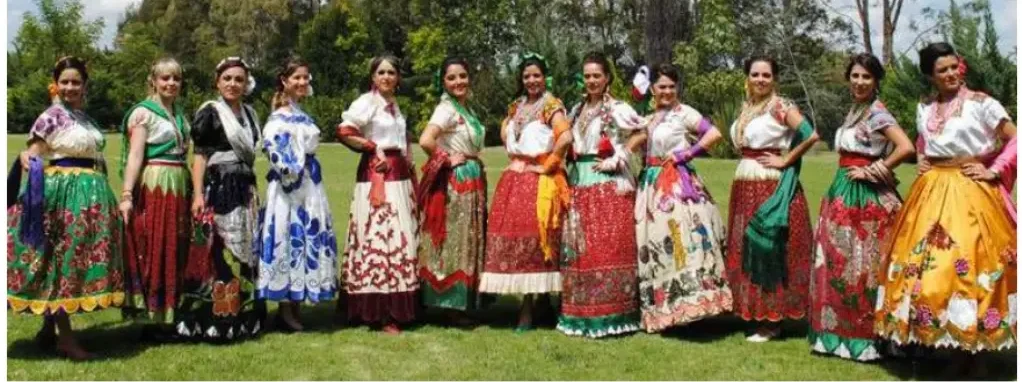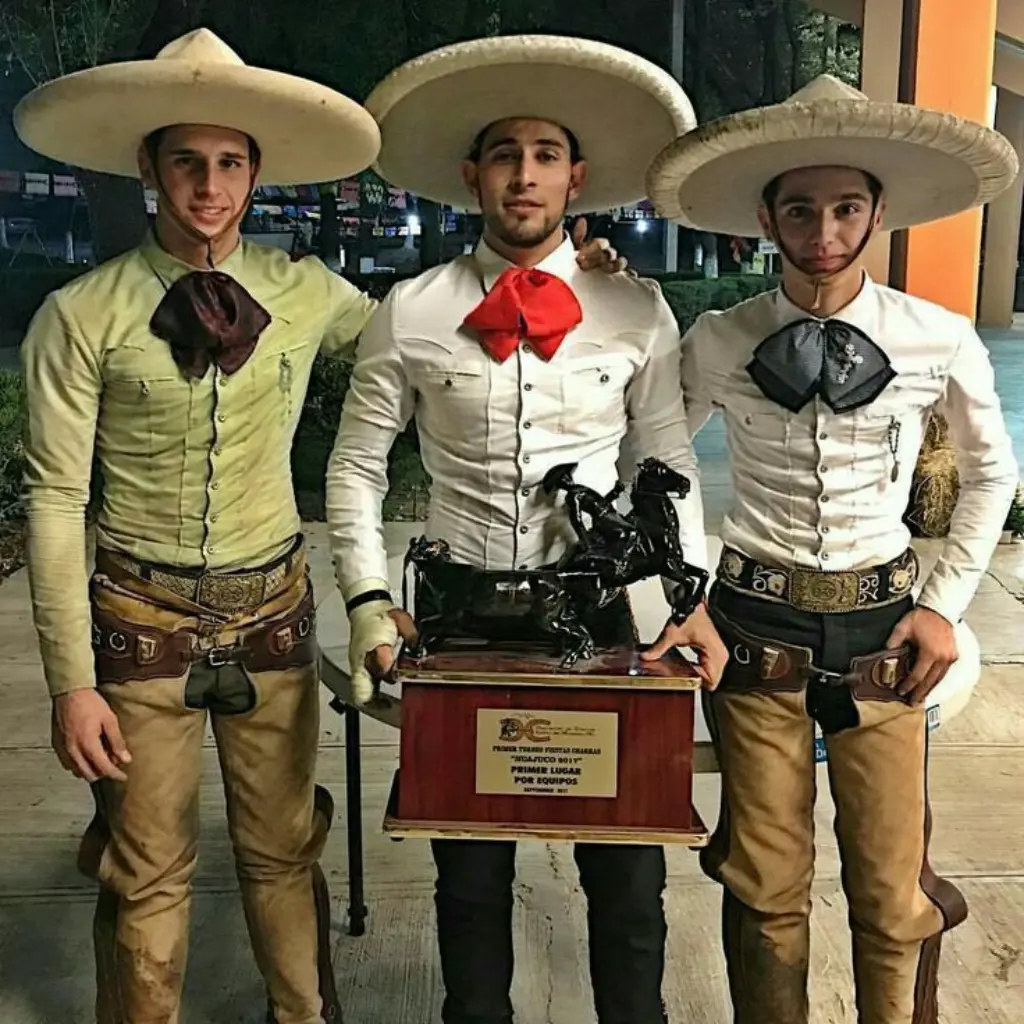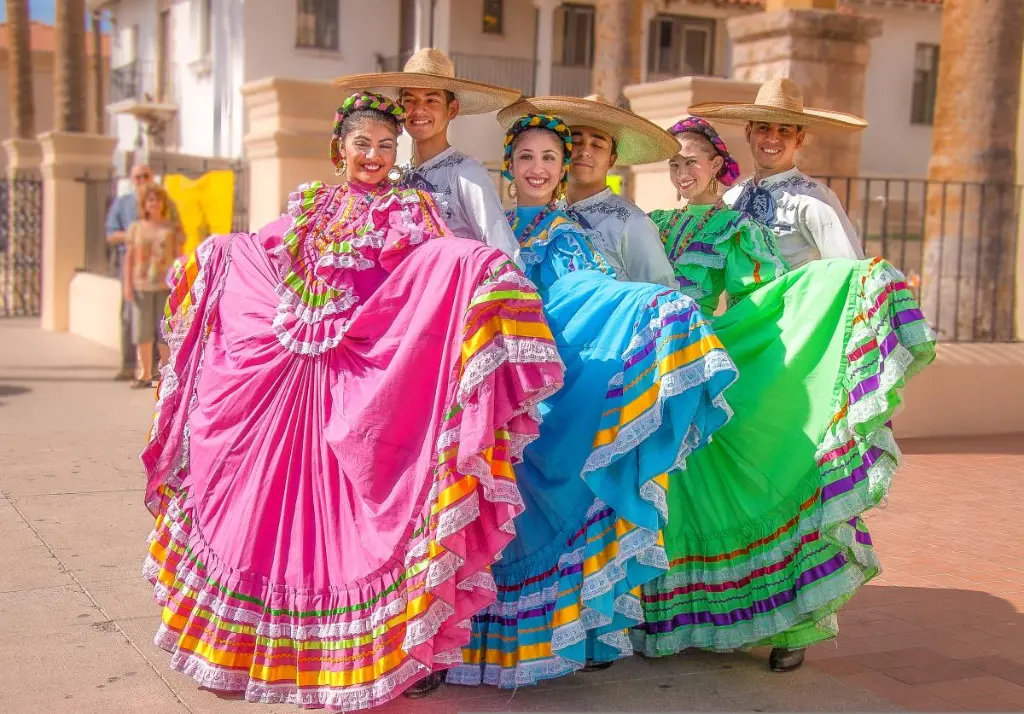Discover the vibrant world of traditional Mexican clothing — from the handwoven huipil and rebozo to the dazzling charro suit. Explore cultural roots, regional styles, and living heritage.
Close your eyes and picture Mexico. You might see sun-drenched plazas, towering cacti, or bustling markets bursting with color. But look closer — and you’ll see the people. A woman in a flowing, hand-embroidered huipil, its patterns whispering ancient stories. A man on horseback in a silver-trimmed charro suit, radiating pride and precision. A dancer swirling in a ruffled China Poblana dress, ribbons flying like fireworks.
This is traditional Mexican clothing — not costume, but culture stitched into every thread. In this article, we’ll journey from indigenous villages to rodeo arenas, uncovering how garments like the rebozo, serape, and sombrero carry centuries of history, identity, and artistry. Get ready to fall in love with fabric that dances, embroidery that speaks, and style that never goes out of fashion.
What Is Traditional Mexican Clothing?

Traditional Mexican clothing refers to the historic and culturally significant garments worn by Mexico’s diverse communities — from pre-Hispanic times to today. It’s not one style, but hundreds — shaped by geography, climate, ethnicity, and occasion.
See also Traditional Clothing in Saudi Arabia: The Elegance of Thobe and Abaya
Traditional Clothing in Saudi Arabia: The Elegance of Thobe and AbayaUnlike fast fashion, these pieces are often handmade, using techniques passed down for generations. They tell stories — of gods and harvests, love and loss, resistance and celebration.
Key characteristics:
- Handcrafted: Woven on backstrap looms, embroidered by hand, dyed with natural pigments.
- Symbolic: Patterns and colors carry spiritual, regional, or personal meaning.
- Functional: Designed for climate (hot sun, cool mountains) and lifestyle (farming, dancing, riding).
- Layered Identity: Blends Indigenous, Spanish, African, and global influences into something uniquely Mexican.
A Brief History: Threads Through Time
Mexican dress is a tapestry woven from many cultures — each adding its own vibrant strand.
Pre-Hispanic Roots
Before the Spanish arrived in 1519, Indigenous groups like the Aztecs, Maya, Zapotec, and Mixtec wore garments made from cotton, agave fiber, and feathers.
See also Traditional Ghanaian Clothing: The Symbolism of Kente Cloth
Traditional Ghanaian Clothing: The Symbolism of Kente Cloth- Men: Maxtlatl (loincloth) and tilmatli (cape).
- Women: Huipil (tunic) and cueitl (skirt).
Clothing denoted status, profession, and even cosmic beliefs. Bright dyes came from insects, plants, and minerals.
Colonial Fusion (1521–1821)
Spanish rule brought new fabrics (silk, wool), tailoring, and Catholic modesty norms. Indigenous weavers adapted — blending old motifs with European cuts.
The rebozo (shawl) emerged during this time — a perfect fusion of Indigenous wrapping traditions and Spanish lace-making.
Independence & National Identity (1821–Present)
After independence, Mexicans sought symbols of unity. The charro suit and China Poblana dress became national icons — romanticized in film, music, and festivals.
Today, traditional Mexican clothing thrives — worn daily in rural areas, celebrated at festivals, and reimagined by designers worldwide.
Women’s Attire: Huipiles, Rebozos, and Embroidered Poetry
Mexican women’s dress is a masterpiece of color, craft, and cultural coding. Let’s meet its stars.

The Huipil: A Woven Universe
The huipil (pronounced “wee-peel”) is a loose, sleeveless or short-sleeved tunic, worn by Indigenous women across southern Mexico and Central America.
Each huipil is a universe:
- Patterns: Zigzags (mountains), diamonds (cosmos), animals (spirit guides), flowers (fertility).
- Colors: Red (life, blood), blue (water, sky), white (purity), black (earth, death).
- Construction: Often woven on a backstrap loom — a technique over 3,000 years old.
A woman’s huipil can signal:
- Her village (Oaxaca vs. Chiapas vs. Yucatán)
- Her marital status
- Her role in ceremonies
In Zinacantán, Chiapas, brides wear huipiles so heavy with embroidery they weigh over 10 pounds!
The Rebozo: Mexico’s Versatile Shawl
The rebozo is a long, rectangular shawl — worn by women of all classes for centuries. It’s practical, beautiful, and deeply symbolic.
Uses:
- Carrying babies (wrapped snugly against the back)
- Shielding from sun or cold
- Mourning (black rebozos)
- Dance accessory (swirled dramatically in folklórico)
Materials range from cotton (everyday) to silk (festive). Fringes are often intricately knotted — a skill taking months to master.
Famous wearers: Frida Kahlo, whose self-portraits made the rebozo an icon of strength and identity.
The China Poblana: National Symbol
Despite its name (“Chinese woman from Puebla”), this outfit has no Asian roots. It likely evolved from 17th-century dresses worn by urban mestizo women.
Key features:
- White blouse with sequins or beads
- Colorful, sequined skirt with patriotic eagle motif
- Rebozo draped over shoulders
Popularized in the 19th century, it’s now worn mainly for dance performances and festivals — a glittering emblem of Mexican femininity.
Men’s Attire: Charros, Serapes, and Cowboy Cool
Mexican men’s traditional dress blends Indigenous practicality with Spanish flair — and nowhere is this more dazzling than in the charro suit.

The Charro Suit: Mexico’s National Costume
Born in the haciendas of central Mexico, the traje de charro (charro suit) was worn by horsemen who managed cattle ranches. Today, it’s Mexico’s official national attire — worn at weddings, Independence Day, and mariachi performances.
Elements:
- Tight-fitting pants with silver buttons down the sides
- Short, embroidered jacket (chaquetilla)
- Wide bow tie (corbatín)
- Sombrero de charro — wide-brimmed, often decorated with silver or gold thread
- Botines — ankle boots, sometimes with spurs
A full suit can cost thousands of dollars — and take months to make. Silver embroidery might depict national symbols: eagles, cacti, or Aztec calendars.
Fun fact: Mariachi musicians adopted the charro suit in the 1930s to project a unified, dignified image — and it stuck.
The Serape and Sarape: Blanket as Outerwear
Don’t confuse them!
- Serape: Worn over the shoulders like a poncho — often striped, wool, from Saltillo or Tlaxcala.
- Sarape: A blanket, though sometimes used interchangeably.
Bright stripes (red, yellow, blue) ward off evil spirits in some traditions. Perfect for chilly mountain nights or adding flair to a simple outfit.
Guayabera: The Elegant Shirt
Though Cuban in origin, the guayabera — a lightweight, pleated shirt with vertical rows of embroidery — is beloved across Mexico, especially in Yucatán and Veracruz.
Worn untucked, it’s ideal for hot weather. Perfect for weddings, quinceañeras, or Sunday Mass.
Regional Styles: A Map in Fabric
Mexico’s diversity shines in its dress. Here’s a quick tour:

Oaxaca: Land of the Huipil
Home to dozens of Indigenous groups, Oaxaca boasts some of Mexico’s most intricate textiles.
- Zapotec weavers (Teotitlán del Valle): Wool rugs and huipiles with geometric patterns.
- Mixtec embroiderers (Santiago Choapam): Floral huipiles with satin stitch.
- Isthmus of Tehuantepec: Famous for flamboyant, gold-embroidered velvet huipiles worn by Tehuanas — strong, matriarchal women immortalized by Frida Kahlo.
Chiapas: Maya Masterpieces
Maya communities here create huipiles dense with symbolism.
- Zinacantán: Pink floral embroidery on white, representing flowers offered to saints.
- Chamula: Dark wool tunics with rainbow stripes — each color sacred.
- San Juan Chamula: Men wear wool tunics and tzotzil-language sashes.
Yucatán: Cool Cotton and Cross-Stitch
Hot climate = light fabrics. The huipil yucateco is typically white cotton, embroidered with colorful floral or bird motifs in cross-stitch (xok bil).
Women pair it with a terno — a three-piece dress including a flounced skirt and lace-edged headscarf.
Northern Mexico: Cowboys and Charros
Ranch culture dominates. Think leather boots, denim, wide-brimmed hats — and of course, the charro suit for special occasions.
Saltillo, Coahuila, is famous for its striped serapes — once traded as currency!
| Region | Iconic Garment | Key Features |
|---|---|---|
| Oaxaca | Zapotec Huipil | Geometric wool patterns, natural dyes |
| Chiapas | Zinacantán Huipil | Heavy pink floral embroidery |
| Yucatán | Terno Dress | White cotton, cross-stitch florals |
| Jalisco | Charro Suit | Silver embroidery, wide sombrero |
Craftsmanship: Backstrap Looms, Natural Dyes, and Living Hands
Behind every huipil or rebozo is astonishing skill — often practiced in homes, passed mother to daughter.
Backstrap Loom Weaving
Used for over 3,000 years, this portable loom consists of sticks and straps tied around the weaver’s body. It allows incredible precision — but requires immense strength and patience.
Patterns are never written down — memorized and improvised, making each piece unique.
Natural Dyes: Earth, Insects, and Plants
Before synthetic dyes, artisans used:
- Cochineal insects → brilliant red
- Indigo plants → deep blue
- Pomegranate skins → yellow
- Walnut shells → brown
Many cooperatives still use these methods — eco-friendly and stunningly vibrant.
Embroidery Styles
- Tenango (Hidalgo): Whimsical animals and plants on manta cloth.
- Otomi (Querétaro): Mythical creatures in bright chain stitch.
- Zapotec (Oaxaca): Geometric precision in wool.
Traditional Mexican Clothing Today: Pride, Preservation, and Problems
These garments aren’t museum pieces — they’re alive. But they face challenges.
Festivals and Folkloric Dance
Events like Guelaguetza (Oaxaca) or Carnaval (Veracruz) are explosions of traditional dress. Folkloric dance troupes wear meticulously researched costumes — keeping styles alive for new generations.
Fashion Revival
Designers like Carla Fernández and Lydia Lavín collaborate with Indigenous artisans, creating modern pieces inspired by traditional techniques. Runways in Paris and New York now feature huipil-inspired tops and rebozo silhouettes.
Cultural Appropriation vs. Appreciation
Fast fashion brands often copy Indigenous patterns without credit or compensation. This erases context and exploits artisans.
Solution? Buy direct from cooperatives. Credit origins. Understand meanings.
Threats to Tradition
- Mass production: Cheap imitations undercut artisans.
- Migration: Young people leave villages for cities, abandoning weaving.
- Climate change: Affects dye plants and cotton crops.
How to Wear and Respect Traditional Mexican Clothing
Want to embrace these styles? Do it right.
✅ Buy Authentic: Support cooperatives like Sna Jolobil (Chiapas) or Taller Maya (Yucatán).
✅ Learn the Story: Ask about patterns, weavers, and meanings.
✅ Wear with Respect: Avoid sacred ceremonial pieces as costumes.
✅ Credit Artisans: If posting photos, tag makers or communities.
🚫 Don’t: Buy mass-produced “ethnic” prints from big retailers. Wear religious garments as party outfits. Claim designs as your own.
Conclusion
Traditional Mexican clothing is more than fabric — it’s philosophy, prayer, and poetry woven into wearable art. A huipil holds the cosmos. A charro suit carries national pride. A rebozo cradles generations. These garments survived conquest, revolution, and globalization because they’re rooted in something deeper than trend: identity.
Today, as young Mexicans reclaim their heritage and global audiences fall in love with these textiles, the threads grow stronger — not weaker. When you wear or admire a piece of traditional Mexican clothing, you’re not just appreciating beauty. You’re honoring resilience. You’re celebrating a culture that turns thread into legacy.
So what can you do?
👉 Visit Mexico — go beyond resorts. Visit artisan villages. Attend a Guelaguetza.
👉 Support fairly — buy directly from weavers. Pay fair prices.
👉 Educate yourself — learn the difference between appropriation and appreciation.
👉 Share respectfully — post photos with context. Tag creators. Tell the story.
Because in a world of disposable fashion, Mexican textiles remind us: true style is timeless. And it’s made by hand, heart, and history.
References (APA Style)
Anawalt, P. R. (1981). Indian Clothing Before Cortés: Mesoamerican Costumes from the Codices. University of Oklahoma Press.
Berlo, J. C. (Ed.). (1997). Textile Traditions of Mesoamerica and the Andes: An Anthology. University of Texas Press.
Franquemont, E. (2009). Respect the Spindle: Spin Infinite Yarns with One Amazing Tool. Interweave.
José, M. (2018). Textiles of Mexico: The Art of Tradition. Artes de México.
Sayer, C. (1985). Costumes of Mexico. University of Texas Press.
Secretaría de Cultura. (n.d.). Patrimonio Cultural Inmaterial. Retrieved from https://www.cultura.gob.mx




